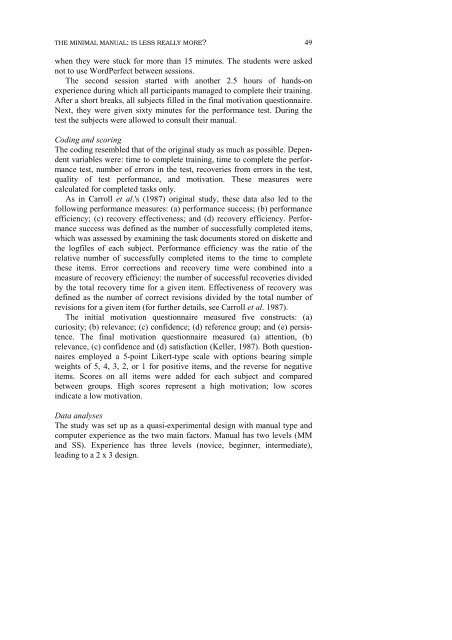MINIMALIST COMPUTER DOCUMENTATION - Universiteit Twente
MINIMALIST COMPUTER DOCUMENTATION - Universiteit Twente
MINIMALIST COMPUTER DOCUMENTATION - Universiteit Twente
Create successful ePaper yourself
Turn your PDF publications into a flip-book with our unique Google optimized e-Paper software.
THE MINIMAL MANUAL: IS LESS REALLY MORE?<br />
when they were stuck for more than 15 minutes. The students were asked<br />
not to use WordPerfect between sessions.<br />
The second session started with another 2.5 hours of hands-on<br />
experience during which all participants managed to complete their training.<br />
After a short breaks, all subjects filled in the final motivation questionnaire.<br />
Next, they were given sixty minutes for the performance test. During the<br />
test the subjects were allowed to consult their manual.<br />
Coding and scoring<br />
The coding resembled that of the original study as much as possible. Dependent<br />
variables were: time to complete training, time to complete the performance<br />
test, number of errors in the test, recoveries from errors in the test,<br />
quality of test performance, and motivation. These measures were<br />
calculated for completed tasks only.<br />
As in Carroll et al.'s (1987) original study, these data also led to the<br />
following performance measures: (a) performance success; (b) performance<br />
efficiency; (c) recovery effectiveness; and (d) recovery efficiency. Performance<br />
success was defined as the number of successfully completed items,<br />
which was assessed by examining the task documents stored on diskette and<br />
the logfiles of each subject. Performance efficiency was the ratio of the<br />
relative number of successfully completed items to the time to complete<br />
these items. Error corrections and recovery time were combined into a<br />
measure of recovery efficiency: the number of successful recoveries divided<br />
by the total recovery time for a given item. Effectiveness of recovery was<br />
defined as the number of correct revisions divided by the total number of<br />
revisions for a given item (for further details, see Carroll et al. 1987).<br />
The initial motivation questionnaire measured five constructs: (a)<br />
curiosity; (b) relevance; (c) confidence; (d) reference group; and (e) persistence.<br />
The final motivation questionnaire measured (a) attention, (b)<br />
relevance, (c) confidence and (d) satisfaction (Keller, 1987). Both questionnaires<br />
employed a 5-point Likert-type scale with options bearing simple<br />
weights of 5, 4, 3, 2, or 1 for positive items, and the reverse for negative<br />
items. Scores on all items were added for each subject and compared<br />
between groups. High scores represent a high motivation; low scores<br />
indicate a low motivation.<br />
Data analyses<br />
The study was set up as a quasi-experimental design with manual type and<br />
computer experience as the two main factors. Manual has two levels (MM<br />
and SS). Experience has three levels (novice, beginner, intermediate),<br />
leading to a 2 x 3 design.<br />
49
















